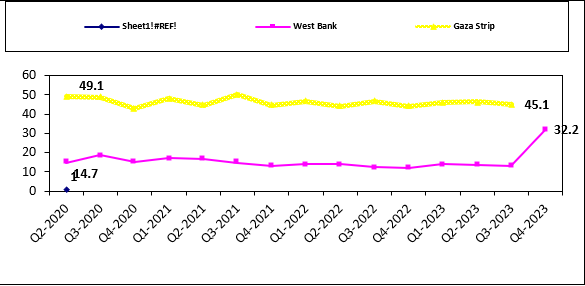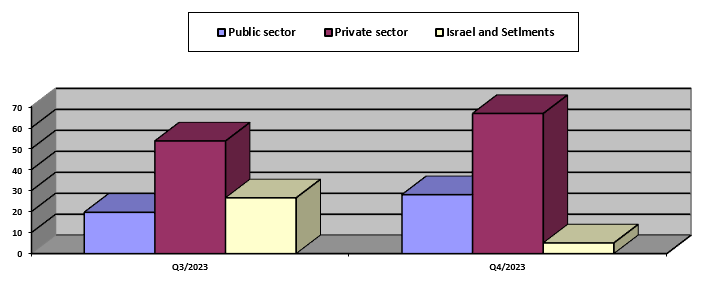Palestinian Central Bureau of Statistics (PCBS)
On the occasion of the International Workers' Day, H.E. Dr. Ola Awad, President of Palestinian Central Bureau of Statistics (PCBS),
presents the current status of the Palestinian labour force in 2023
In light of the ongoing Israeli Aggression on Gaza Strip since October 7th, 2023, H.E. Dr. Ola Awad, President of PCBS, presents the properties of the Palestinians Labour Force on the occasion of the International Workers' Day, which helps in identifying issues and determinants that shall govern the prospects and potentials of the future of the Palestinian Labour Force.
Due to the ongoing Israeli occupation aggression against Gaza Strip since October 7th, 2023 that led to the suspension of economy in Gaza Strip indefinitely, addressing labour force properties in Gaza Strip is unrealistic and useless. As of October 7th, 2023, unemployment rates reached unpreceded levels (estimates show that unemployment rates increased to 75% in the 4th quarter of 2023, compared to 46% in the 3rd quarter of the same year).
Moreover, the majority of the labor force concepts became un-applicable to be used for measuring the labor force characteristics in Gaza Strip, taking the priority of Gaza’s people are looking for shelter, food, and safety.
This impact has not only been reflected on Gaza Strip, but also on the West Bank, even if it was less affected. The impact of the Israeli aggression on Gaza Strip and its repercussions in the West Bank of increasing restrictions and tightening the stranglehold on the governorates of the West Bank, disconnecting communication and roads between the governorates, as well as forbidding workers to access their work inside the occupied territories of Palestine. Where all these reasons and other more have paralyzed the economic movement in West Bank.
As for the West Bank, the number of unemployed persons increased to reach 317 thousand in the 4th of 2023 compared to about 129 thousand in the 3rd quarter of the same year, i.e. before the Israeli aggression. Also, unemployment rates among participants in the labour force in the West Bank increased to about 32% in the 4th quarter of 2023 compared to 13% in the 3rd quarter of the same year. Unemployment rate increased among both males and females to reach 33.9% and 24.6%, respectively, in the 4th quarter of 2023.
Unemployment Rate among participants in the labour force (15 years above) in the West Bank, Q1- 2022 – Q4-2023
A decrease of about 203 thousand in the number of employed persons from the West Bank in the 4th quarter of 2023
The number of employed persons (excluding employees abroad) decreased from about 868 thousand in the 3rd quarter of 2023 to about 665 thousand employed persons in the 4th quarter of 2023 with a percentage of 23%.
Moreover, the number of employed persons from the West Bank in Israel decreased between the 3rd quarter and 4th quarter of 2023 by about 130 thousand employed persons, because of the strict closures imposed by Israeli occupation after the war on Gaza Strip, where the number of employed persons in Israel was about 17 thousand in the 4th quarter of 2023 compared to about 147 thousand in the 3rd quarter of 2023.
The number of employed persons in the Israeli settlements decreased from 25 thousand in the 3rd quarter to 7 thousand in the 4th quarter of 2023.
A decrease in the number of employed persons in the local market in the West Bank between the 3rd and 4th quarter of 2023
The number of employed persons in the local market in the West Bank decreased from 697 thousand in the 3rd quarter to 640 thousand in the 4th quarter of 2023 of about 8%.
Results showed that the decrease in the number of employed persons in the local market in the West Bank is due to the decrease in the number of employed persons in constructions activity, followed by commerce activity, restaurants and hotels activity, followed by mining manufacturing activity and other services[1] activity, and agriculture activity, finally transportations and storage activity.
The private sector is the main employer
The number of employed persons from the West Bank reached 665 thousand; 641thousand in the West Bank, and 24 thousand in Israel and Israeli settlements. There are about 447 thousand wage employees in Palestine (425 thousand of them in the West Bank, 17 thousand in Israel and 7 thousand in the Israeli settlements).
About 67% of wage employees in the West Bank are working in the private sector, compared with about 28% employed persons in the public sector, and 5% of wage employees are working in Israel and Israeli Settlements.
Percentage Distribution of Wage Employees from the West Bank by
Sector, Q3- Q4 2023
One fourth of wage employees in the private sector work as professionals or technicians
About 25% of wage employees in the private sector work as professionals or technicians in the West Bank; with a percentage of 14% among males and 69% among females.
More than half of employed persons are in the informal employment in the West Bank
The informal employment reached about 56% in the West Bank in the 4th quarter of 2023 compared with 67% in the 3rd quarter of 2023 (knowingly, workers in the informal sector and wage employees who do not receive any of their rights in the labour market whether retirement/end-of-service gratuity, paid annual leave or paid sick leave); 61% among males compared to 37% among females. Also, the percentage of employed persons in the informal sector reached 41% in the West Bank; 46% among males and 22% among females compared with 45% in the 3rd quarter of 2023.
Low average of real wages in the private sector
The real average daily wage (base year= 2018) in the private sector was about 127 NIS in the West Bank compared with 125.5 NIS in the 3rd quarter of 2023 (Wage employees in Israel and Israeli settlements are excluded).
The constructions activity in the private sector recorded the highest average of real daily wage of 153 NIS, followed by transports, storage activity with about 146 NIS. While the agriculture activity recorded the lowest average real daily wage at 86 NIS in the West Bank.
In the same context, the average of actual weekly work hours for wage employees in Palestine was 43 hours; 41 hours for wage employees in the public sector, and 43 weekly work hours for wage employees in the private sector.
15% of wage employees receive less than the minimum monthly wage (1,880 NIS) in the West Bank.
The percentage of wage employees in the private sector who receive a monthly wage less than the minimum wages in the West Bank was 15% in the 4th quarter of 2023 (about 40 thousand employees) compared with 12% about (36 thousand) in the 3rd quarter of 2023.
It is worth mentioning that the Council of Ministers issued a decree stating that the minimum wage is to be (1,880 NIS) as of the beginning of 2022.
The average monthly wage, for those who receive less than the minimum wage, was 1,387 NIS in the West Bank, compared with 1,432 NIS in the 3rd quarter of 2023.
Less than half of the private sector’s wage employees receive benefits
About 48% of the private sector's wage employees receive benefits (retirement/end-of-service gratuity, paid annual leave and paid sick leave). Thus, the number of wage employees in the private sector who had written permanent contract was about 62 thousand employed persons, about 128 thousand employed persons in the private sector have temporary contract, and about 109 thousand employed persons with no contract. However, about 50% of wage females employees who work in the private sector got a paid maternity leave compared to 51% in the 3rd quarter of 2023.
[1] Includes: Public administration and defense; compulsory social security, education, human health activities, social work activities, creative, arts and entertainment activities, libraries, archives, museums and other cultural activities, sports activities and amusement and recreation activities, activities of membership organizations, other personal service activities, activities of households as employers of domestic personnel and activities of extraterritorial organizations and bodies
 عربي
عربي

